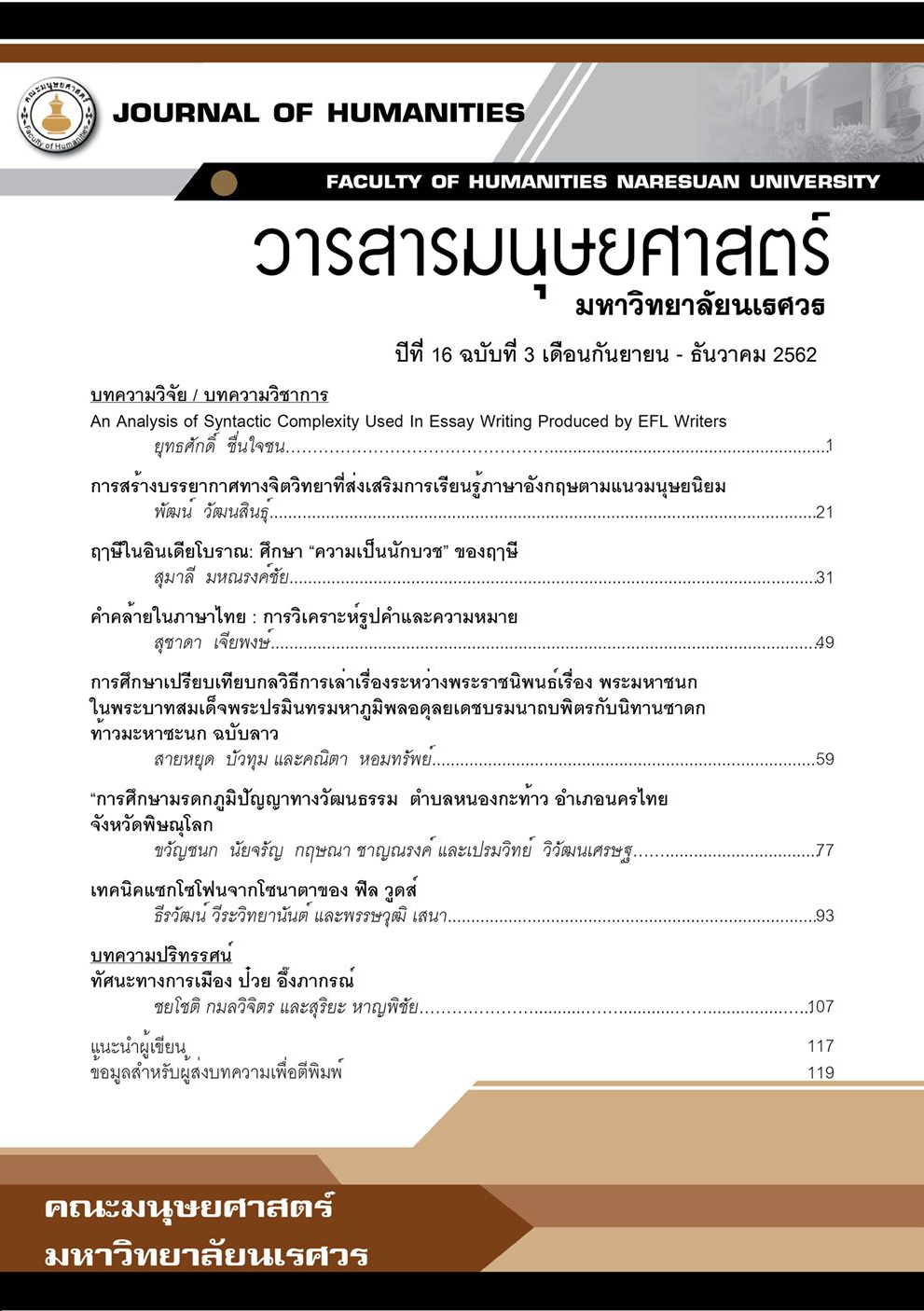การวิเคราะห์เรื่องการเขียนประโยคที่ซับซ้อนในงานเขียนเรียงความ ของผู้เรียนเขียนภาษาอังกฤษในฐานะภาษาต่างประเทศ
Main Article Content
บทคัดย่อ
วัตถุประสงค์ของงานวิจัยนี้ เพื่อศึกษาความซับซ้อนของการเขียนเรียงความภาษาอังกฤษและประเภทของอนุประโยคที่เขียนโดยผู้เรียนภาษาอังกฤษในฐานะภาษาต่างประเทศ โดยศึกษากับนิสิตระดับปริญญาตรี ชั้นปีที่ 3 ภาควิชาภาษาอังกฤษ มหาวิทยาลัยนเรศวร ที่ลงทะเบียนเรียนในรายวิชาการเขียนเรียงความ (205223) จำนวน 49 คน นิสิตดังกล่าวได้ทำข้อสอบการเขียนเรียงความเชิงโต้แย้ง โดยต้องเลือก 1 จาก 3 หัวข้อที่กำหนดให้ไว้ จากนั้น ผู้วิจัยเก็บเรียงความและนำไปวิเคราะห์โดยเน้นในเรื่อง 1) อัตราส่วนของอนุประโยคในประโยค 2) อัตราส่วนของ อนุประโยคพึ่งพิงในอนุประโยค และ 3) อัตราส่วนของอนุประโยคพึ่งพิงในประโยค ผลการวิจัยพบว่าเครื่องมือที่ใช้ ในการวิเคราะห์ความซับซ้อนของประโยคมีประสิทธิภาพในการหาความซับซ้อนของประโยค ทั้งนี้ยังพบว่านิสิต ในงานวิจัยนี้มีการใช้อนุประโยคที่ทำหน้าที่เสมือนคำนามมากที่สุด รองลงมาคืออนุประโยคที่ทำหน้าที่เสมือนคำกริยาวิเศษณ์ และอนุประโยคที่ทำหน้าที่เสมือนคำคุณศัพท์ ส่วนท้ายงานวิจัยนี้มีข้อเสนอแนะทางด้านการสอนและข้อแนะนำสำหรับงานวิจัยในภายหน้าเกี่ยวกับการสอนและการทำวิจัยด้านการเขียนภาษาอังกฤษในระดับประโยค
Article Details

อนุญาตภายใต้เงื่อนไข Creative Commons Attribution-NonCommercial-NoDerivatives 4.0 International License.
ข้อความรู้ใด ๆ ตลอดจนข้อคิดเห็นใด ๆ เป็นของผู้เขียนแต่ละท่านโดยเฉพาะ คณะมนุษยศาสตร์ มหาวิทยาลัยนเรศวร และกองบรรณาธิการวารสารมนุษยศาสตร์ฯ ไม่จำเป็นต้องเห็นพ้องด้วย
เอกสารอ้างอิง
Ai, H., & Lu, X. (2013). A corpus-based comparison of syntactic complexity in NNS and NS university students’ writing. In A. Díaz-Negrillo, N. Ballier & P. Thompson (Eds.), Automatic treatment and analysis of learner corpus data (pp. 249–264). Amsterdam: John Benjamins
Biber, D., & Gray, B. (2016). Grammatical complexity in academic English: Linguistic change in writing. Cambridge: Cambridge University Press.
Biber, D., Gray, B., & Poonpon, K. (2011). Should we use characteristics of conversation to measure grammatical complexity in L2 writing development? TESOL Quarterly, 45, 5-35.
British Council, IDP Education, & University of Cambridge (2018). IELTS task 2: Writing band descriptors (public version). Retrieved January 25, 2018, from https://takeielts.britishcouncil.org/sites/default/files/2018-01/IELTS_task_2_Writing_band_descriptors.pdf
Bulté, B., & Housen, A. (2012). Defining and Operationalising L2 Complexity. In A. Housen, F. Kuiken, & I. Vedder (Eds), Dimensions of L2 performance and proficiency - investigating complexity, accuracy and fluency in SLA (pp. 21-46). Amsterdam: John Benjamins.
Bulté, B., & Housen, A. (2014). Conceptualizing and measuring short-term changes in L2 writing complexity. Journal of Second Language Writing, 26, 42–65. doi:10.1016/j.jslw.2014.09.005
Chuenchaichon, Y. (2011). The development of paragraph writing for EFL writers through the use of a reading into writing method. Ph.D. thesis. University of Reading.
Educational Testing Service (2018). TOEFL iBT Test: Writing independent rubrics. Retrieved January 25, 2018, from https://www.ets.org/s/toefl/pdf/toefl_writing_rubrics.pdf
Hunt, K. (1966). Recent measures in syntactic development. Elementary English, 43, 732-739.
Hyland, K. (2003). Second language writing. Cambridge: Cambridge University Press.
Ji, X. (2009). English development of Chinese EFL student writers from sophomore to senior years. The Journal of Asia TEFL. 6(3), 375-397.
Kim, J. (2014). Predicting L2 writing proficiency using linguistic complexity measures: A corpus-based study. English Teaching, 69(4), 27-51. doi: 10.15858/engtea.69.4.201412.27
Li, Y. (2000). Linguistic characteristics of ESL writing in task-based e-mail activities. System, 28(2), 229-245.
Lu, X. (2010) Automatic analysis of syntactic complexity in second language writing. International Journal of Corpus Linguistics, 15(4), 474 –496. doi: 10.1075/ijcl.15.4.02lu
McWhorter, J. H. (2007). Language interrupted: Signs of non-native acquisition in standard language grammars. New York: Oxford University Press.
Newmeyer, F. J., & Preston, L. B. (2014). Introduction. In F. J. Newmeyer & L. B. Preston (Eds.), Measuring grammatical complexity (pp. 1–13). New York, NY: Oxford University Press.
Ortega, L. (2003). Syntactic complexity measures and their relationship to L2 proficiency: A research synthesis of college-level L2 writing. Applied Linguistics, 24(4), 492-518.
Oshima, A., & Hogue, A. (2006). Writing academic English (4th ed.). White Plains, NY: Pearson Longman.
Pallotti, G. (2015). A simple view of linguistic complexity. Second Language Research, 31(1), 117-134. doi:10.1177/0267658314536435
Polio, C. G. (1997). Measures of linguistic accuracy in second language writing research. Language Learning, 47(1), 101-143.
Seifoori, Z., & Fattahi, J. (2014). The comparison of the method section of applied linguistics articles written by native and Iranian writers in terms of grammatical complexity and clause types. Procedia - Social and Behavioral Sciences, 98, 1698-1705.
Shaw, P., & Ting-Kun Liu, E. (1998). What develops in the development of second-language writing? Applied Linguistics, 19(2), 225-254.
Storch, N. (2009). The impact of studying in a second language (L2) medium university on the development of L2 writing. Journal of Second Language Writing, 18(2), 103-118.
Tai, H. (2015). Writing development in syntactic complexity, accuracy and fluency in a content and language integrated learning class. International Journal of Language and Linguistics, 2(3), 149-156.
Wolfe-Quintero, K., Inagaki, S., & Kim, H.-Y. (1998). Second language development in writing: Measures of fluency, accuracy, and complexity. Honolulu, HI: University of Hawaii Press.
Yang, G. (2015). Grammatical features of structural elaboration and compression common in advanced ESL academic writing. M.A. thesis, Brigham Young University. Retrieved from http://scholarsarchive.byu.edu/cgi/viewcontent.cgi?article=6285&context=etd


